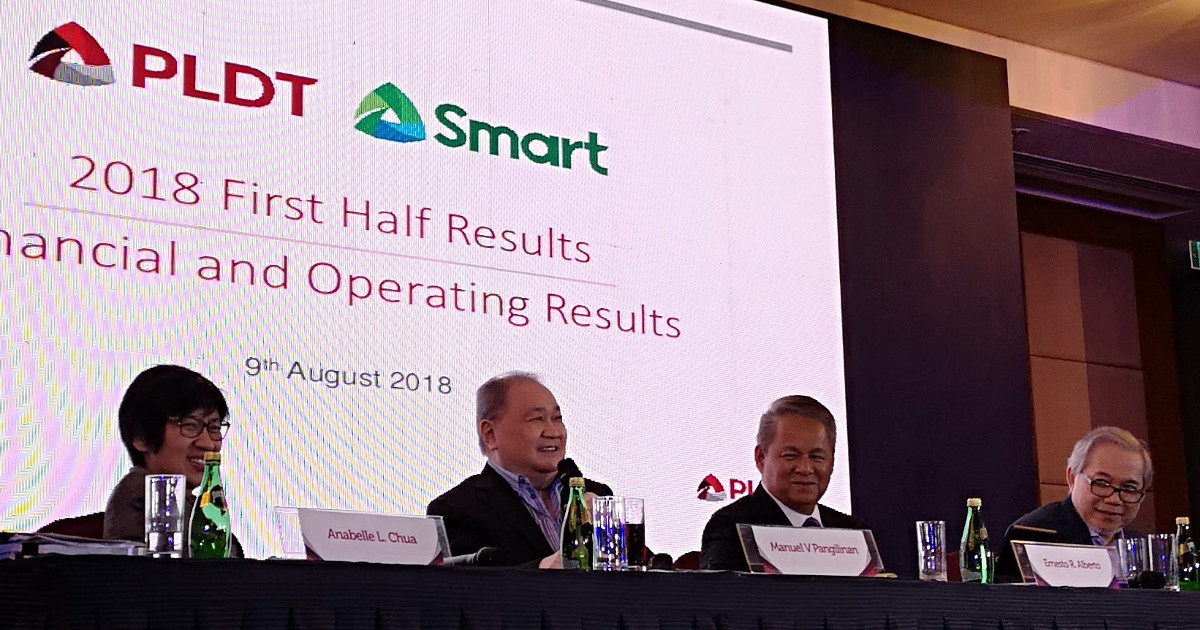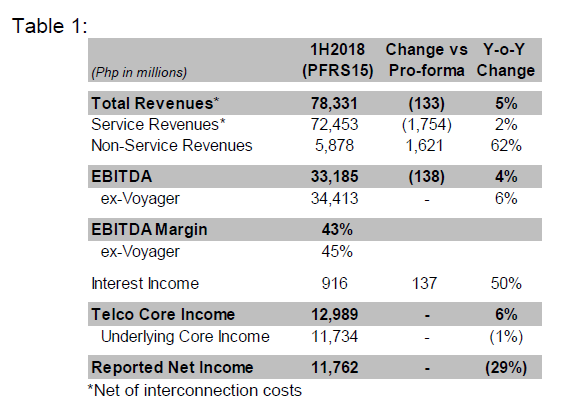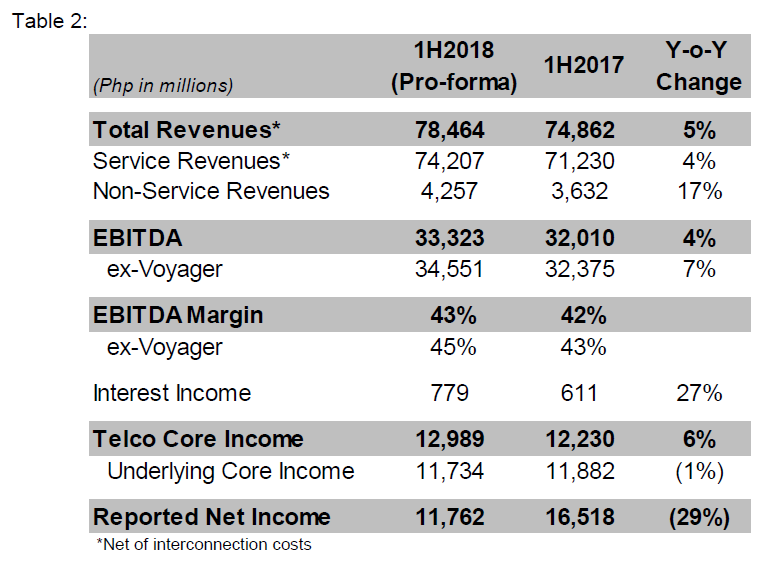
ON-PRO FORMA BASIS (PAS 18): SERVICE REVENUES FOR 1H18 4% HIGHER YEAR-ON-YEAR AT P74.2 BILLION EXCLUDING ILD/NLD, CONSOLIDATED SERVICE REVENUES ROSE 6%
COMBINED HOME, ENTERPRISE AND INDIVIDUAL SERVICE REVENUES
(90% OF TOTAL CONSOLIDATED REVENUES) UP BY 7% AT P66.6 BILLION
HOME AND ENTERPRISE SERVICE REVENUES ROSE 14% AND 9%, RESPECTIVELY
INDIVIDUAL SERVICE REVENUES GREW 2% YEAR-ON-YEAR AND 1% QUARTER-ON-QUARTER – THREE SEQUENTIAL QUARTERS OF GROWTH
DATA/BROADBAND REVENUES HIGHER BY 22% AT P39.0 BILLION, NOW 53% OF TOTAL CONSOLIDATED REVENUES
CONSOLIDATED EBITDA ROSE BY 4% TO P33.3 BILLION, OR BY 7% (EX-VOYAGER) TO P34.6 BILLION
CONSOLIDATED CORE INCOME AT P13.1 BILLION
TELCO CORE INCOME (EX-VOYAGER AND ASSET SALES) GREW BY 6% TO P13.0 BILLION
REPORTED NET INCOME OF P11.8 BILLION, IMPACTED BY ACCELERATED DEPRECIATION OF P3.6 BILLION
INTERIM DIVIDEND OF P36 PER SHARE DECLARED
PLDT NETWORK RECOGNIZED BY OOKLA FOR FASTEST FIXED AND MOBILE NETWORK IN THE PHILIPPINES
CORE INCOME GUIDANCE FOR 2018 OF P23-24 BILLION (EX-VOYAGER AND PRE-P FRS 15) AFFIRMED DESPITE HEADWINDS

PLDT Inc. (“PLDT”) (PSE: TEL) (NYSE: PHI) today announced its unaudited financial and operating results for the first half (1H) of 2018 with Consolidated Service Revenues (net of interconnection costs) amounting to P72.5 billion, following the new accounting standard PFRS 15 adopted in 1 January 2018. This represents a 2% increase from 1H 2017. If based on the previous accounting standard, PAS 18, service revenues amounted to P74.2 billion, a 4% rise from the previous year. Excluding ILD/NLD revenues, service revenues were actually higher by 6% year-on-year.
Consolidated EBITDA reached P33.2 billion (based on PFRS 15) or P33.3 billion (based on PAS 18), a 4% increase from 1H 2017. EBITDA Margin improved slightly to 43% from 42% in the previous year.
Core income from telco operations (i. e., excluding Voyager) grew 6% year-on-year to P13.0 billion. With Voyager, core income would be P11.7 billion, slightly lower by 1%.
Taking the following into account, among others:
• P1.4 billion gain from the sale of 6.8 million Rocket Internet shares
• P1.5 billion revaluation gain on the remaining Rocket Internet shares we hold
• P3.6 billion in accelerated depreciation arising from the shortened estimated useful life of some network assets resulting from PLDT’s aggressive network transformation program
Reported Net Income stood at P11.8 billion, 29% less than the previous year mainly due to a higher gain from asset sales in 1H 2017.
Today, the Board of Directors declared an interim dividend of P36 per share in line with the Company’s dividend policy of a 60% payout of the underlying core income of P11.7 billion and 60% of the gain from asset sale of P1.4 billion. The dividend is payable on 11 September 2018 to stockholders on record as of 28 August 2018.
As of end-June 2018, Consolidated Net Debt and Net Debt to EBITDA stood at US$2.4 billion and 1.89x, respectively. Gross Debt totaled US$3.5 billion, of which only US$0.2 billion or 7% is unhedged. Fixed rate loans made up 89%, while floating rate loans accounted for 11%.
The effect of the adoption of PFRS 15 on the Company’s first half 2018 income statement is summarized in Table 1 below:

For purposes of analysis, a comparison of the Company’s first half 2018 results with the same period of 2017 on a pro-forma basis (using PAS 18) is shown in Table 2.
On this basis, Consolidated Service Revenues (net of interconnection costs) rose 4% to P74.2 billion. Revenues in the second quarter of 2018 reached P37.5 billion, the highest level attained on a quarterly basis since 2Q 2016. This also marks the fifth consecutive quarter of steady sequential improvements in service revenues, during which service revenues increased over P1.8 billion. This follows a period covering 5 consecutive quarters starting 2Q 2016 during which service revenues declined by P2 billion – a turnaround of about P3.8 billion.
Consolidated EBITDA grew 4% to P33.3 billion in 1H 2018. Excluding Voyager, EBITDA increased by 7% to P34.6 billion while EBITDA margin improved to 45% from 43% in 1H 2017.

Revenues stay on growth path
Focusing on the contributions of the major business segments, PLDT Home set the pace for growth once more, increasing revenues in 1H 2018 by 14% year-on-year to P18 billion, an improvement of the 12% growth posted in 1H 2017. Growth was underpinned by strong demand for its fiber-powered broadband service.
The Enterprise Group posted revenues of P18.7 billion, raising its growth rate to 9% year-on-year in 1H 2018 from 7% year-on-year for 1Q 2018. Growth continued to be driven by increasing wireless data and cloud and other ICT services.
Combined, Home and Enterprise accounted for 50% of total service revenues and rose by 11% or P3.8 billion year-on-year.
Continuing its turnaround, the Individual Wireless business group posted revenues of P29.9 billion, a 2% increase year-on-year, driven chiefly by growing mobile data revenues.
Data and Digital keep powering growth
Data/broadband and digital services continued to be the main growth drivers for all three business segments. Combined, these services accounted for P39.6 billion in revenues, 54% of 1H 2018 total service revenues, up from 46% in 1H 2017.
Fixed Home broadband revenues jumped 58% to P13.2 billion, while mobile internet revenues surged 29% to P12.3 billion. Corporate data and data center revenues increased 13% to 10.9 billion. As a result, data/broadband and digital services increased their share of revenues to 75%, 64% and 45% for the Home, Enterprise and Individual business segments, respectively.
“We have crossed an important threshold now that our data and digital services generate more than half of our total service revenues. Moving forward, our task is to accelerate our digital pivot by pursuing whenever possible converged digital initiatives across our business segments – Home, Enterprise and Individual Wireless,” said Ernesto R. Alberto, Executive Vice President and Chief Revenue Officer.
Accelerating the network roll-out
In the first half of 2018, PLDT and Smart accelerated the roll out of the group’s fixed and mobile networks, providing a stronger lift for revenue growth.
As of end-June 2018, PLDT increased the coverage of its fiber-power fixed broadband network to 5.1 million homes passed, up from 4 million homes passed as of end-2017. This is nearly 100% of its full-year 2018 target. PLDT boosted its capacity by almost 86% to 1.86 million ports, or, nearly 85% of its full-year target of 2.2 million ports.
Meantime, Smart installed over 3,900 new LTE bases stations, boosting its total count by 45% to over 12,600. This has enabled Smart not only to improve its LTE coverage but also to activate LTE-Advanced (LTE-A), which offers even higher data speeds, in more areas of the country. To complement its LTE roll out, Smart also added over 500 3G base stations, raising the total to over 10,400. The stepped-up roll-out of LTE and 3G base stations will enable Smart to meet its commitment to the government to provide high-speed wireless data services in over 90% of the country’s cities and municipalities earlier than end-2018.
Underpinning PLDT and Smart’s fixed and mobile network roll-out was the expansion of PLDT’s fiber optic transmission and distribution network. In the first half of 2018, PLDT added over 29,000 kilometers of fiber cable, 97% of its full-year 2018 target. This increased its fiber footprint to about 204,000 kilometers, further boosting the reach, capacity and resiliency of PLDT’s fiber network.
“The beneficial impact of these network roll-out efforts has been enhanced by the tighter coordination between our business and network organizations, and, between the fixed and mobile engineering teams. As a result, we are prioritizing the roll-out in areas where there are ready customers. Also, our deployment of network facilities – particularly fiber – more efficiently boost the expansion efforts of both our fixed and mobile network,” said Mario G. Tamayo, Senior Vice President for network planning and engineering for PLDT and Smart.
Winning the speedtest trials
These efforts have progressively improved the coverage and quality of the data and digital services of PLDT and Smart. In July 2018, PLDT and Smart won the speedtest awards from Ookla®, the global leader in internet testing and analysis, for providing the country’s fastest fixed and mobile data services, respectively.
According to Philippine internet user data gathered by Ookla, Smart posted a speed score of 14.98, with an average download speed of 17.25 Mbps and an average upload speed of 7.65 Mbps. PLDT posted a speedtest score of 17.31, with an average download speed of 22.84 Mbps and an average upload speed of 23.45 Mbps.
Earlier, in April 2018, Smart had been cited by leading mobile analytics company OpenSignal for having the country’s fastest LTE network, with an average download speed nationwide of 12.5 Mbps compared to the competition’s 7.7 Mbps.
Even as Smart accelerates its deployment of LTE and LTE-Advanced services, PLDT’s wireless subsidiary is also gearing up to bring to the Philippines 5G, the next generation of wireless data technology.
In August 2018, Smart signed a memorandum of understanding with technology partner Ericsson to do a 5G pilot deployment in Luzon in the first half of 2019. A year earlier, in February 2017, it signed an agreement with strategy and technology partner Huawei Technologies Philippines to jointly conduct research and development on 5G. In line with this, Smart and Huawei conducted 5G speed tests in June 2018 at the recently opened PLDT-Smart 5G TechnoLab and attained data speeds of over 14 Gbps.
These network expansion and modernization efforts are being supported by PLDT’s capital expenditures program for which P58 billion has been earmarked for this year. About P31.5 billion of this amount has been allocated for the wireless network and P26.5 billion for the fixed line network.
This budget also includes investments to upgrade the PLDT group’s various network and customer-facing IT platforms and also covers projects to make its core and transport networks 5G ready. As of June 2018, about 2,000 base stations in the Smart network were already 5G ready.
Home reaps the gains
PLDT’s network investments have started to produce returns. PLDT Home’s revenue growth in the 1H 2018 was driven by a 9% rise year-on-year increase in home penetration to 2.22 million.
At the same time, average revenue per subscriber has increased by 4% as more subscribers sign up for new high-speed fiber plans bundled with video streaming services such as Cignal, iFlix and Netflix. PLDT Home also continues to promote its Best Buy Bundles that offer PLDT, Smart and Cignal TV services in one bill.
To meet the strong demand for fiber-powered home broadband service, PLDT is speeding up the deployment of both fiber-to-the-home (FTTH) lines while transforming existing DSL lines into hybrid fiber-powered broadband lines.
As a complement to the fiber service deployment, PLDT Home has started to also deploy an affordable prepaid fixed wireless broadband service running on Smart’s LTE network.
The fastest LTE network
For the Individual Wireless business, Smart’s roll-out of the country’s fastest mobile data network has been a key factor for its return to growth.
Individual Wireless service revenues reached P29.9 billion in 1H 2018 (based on PAS 18), a modest 2% increase that in fact represented a sharp turnaround from the 17% year-on-year decline posted in 1H 2017. The increase was partly driven by a slight upturn in the number of subscribers of 370,000 from Q1 to Q2 2018. It was also driven by a robust 20% rise in mobile data revenues year-on-year to P13.4 billion in 1H 2018 resulting from higher smartphone ownership and greater data adoption.
Significantly, the contribution of data to total Individual Wireless revenues has risen from 38% in mid-2017 to 45% in mid-2018.
Capitalizing on the group’s massive network build-out, Smart, TNT and Sun stepped up efforts to encourage more of their subscribers to use various data services through attractive data packages and promotions. The most significant initiative so far this year has been the YouTube promo launched in April 2018 under which subscribers get to enjoy an hour of YouTube for free daily if they purchase various mobile data packages.
The promo has succeeded in boosting the number of YouTube users by nearly 400% and the volume of YouTube traffic by over 850%. Moreover, existing subscribers who availed of the YouTube promo increased their top ups by 9% while new subscribers were topping up twice the load value compared to non-YouTube users.
Alongside these promos are the efforts of Smart to get more of its subscribers to switch to LTE smartphones and LTE SIMs. These initiatives have also apparently been helped along by the increased subscriber interest in mobile video viewing stimulated by the free YouTube offer.
The number of new LTE smartphones in the Smart network increased by 53% from Q1 2018 to Q2 2018. LTE handsets now make up one-third of the devices being used in the Smart network and have already surpassed the number of 3G phones. Moreover, efforts to migrate subscribers to LTE plans and packages are bearing fruit, resulting in an over 58% growth in LTE subscribers in 1H 2018 versus 1H 2017.
Smart has extended the free YouTube offer to October to encourage more of its customers to try out mobile video and other data services.
“Our partnership with YouTube has been very successful because mobile video viewing is a powerful driver of data adoption and usage. As the Individual Wireless business pivots further towards data, the way forward for us is clear: help our customers take full advantage of the country’s fastest LTE network by offering compelling data packages and services combined with the best mobile data devices that can deliver the best customer experience,” said Oscar A. Reyes, Jr., Senior Vice President of Consumer Market Development for PLDT and Smart.
Enterprises going more digital
Meantime, revenues of PLDT Enterprise continue to grow on the back of increased demand of businesses for high-speed data, and, digital services and solutions.
Its fixed line business grew 5% in 1H 2018 to nearly P13.6 billion, as the increase of broadband revenues more than compensated for the decline of voice revenues. Wireless service revenues climbed 26% to P3.3 billion due to robust demand for wireless broadband and Internet of Things, Machine-to-Machine and other digital solutions. The ICT businesses of Enterprise rose 17% to P1.8 billion, powered by Cloud infrastructure and Software-as-a-Service (up 35%), Managed IT services (up 25%) and data center services (up 15%).
“The appetite of Philippine enterprises for data and digital solutions is becoming more pervasive and urgent among businesses large and small. This is driven not just by opportunity but also by need. For example, heightened awareness of the importance of digital security is boosting demand for our cyber security solutions,” said Juan Victor Hernandez, Senior Vice President for Enterprise Business.
Voyager: Expanding the digital ecosystem
In the first half of 2018, Voyager Innovations focused its efforts on expanding the reach of its digital products for consumers and enterprises in the areas of financial services, commerce, and marketing technologies. As a result, Voyager recorded exponential growth in the number of unique accounts and transaction volumes across all of its platforms.
For digital payments, PayMaya's unique consumer accounts grew more than five times versus the same period last year. PayMaya is now the leading e-wallet platform in the country, recognized by at least 36% of the population based on the latest Financial Inclusion Survey by the Bangko Sentral ng Pilipinas (BSP).
To further spur adoption and usage in line with its goal of building a 'Cashless Philippines', PayMaya has continued growing its partner merchant network by signing up leading companies like Chooks-to-Go, Araneta Bus Port, LCC Malls, Super8, Megaworld, Rose Pharmacy, Auntie Anne's, Pure Nectar, as well as merchants at the BSP Headquarters in Manila.
Voyager's FINTQnologies (FINTQ), meanwhile, doubled the registered user base of its financial technology platforms – Lendr and KasamaKA. Lendr, its digital lending platform, has helped disbursed nearly P35 billion in loans since it was launched in 2015. Filipinos can now sign up for loans that are relevant to them and access financial products from FINTQ's growing list of partner financial institutions, including the recent additions of Rizal MicroBank, Tala Philippines, and Maybank, among others.
At the same time, more local government units and associations around the country – led by the League of Provinces of the Philippines – have thrown their support behind KasamaKA to digitally empower more Filipinos nationwide through financial inclusion.
These and other initiatives have earned FINTQ the Outstanding Financial Inclusion Partner Award at the recent BSP 2018 Stakeholders' Awards.
Voyagers’ free Internet and rewards platform, freenet, grew its user base 150 times in the first six months of 2018 compared to the same period last year. freenet enables Filipinos to access select mobile apps and sites without data charges, and at the same time explore more of the rest of the Internet by exchanging rewards points earned within the app for prepaid load, data packages, and gaming e-pins.
“Digital inclusion is our overriding goal. We have made significant progress in expanding the digital ecosystem to include more Filipinos," said Orlando B. Vea, Voyager President and CEO.
Conclusion
“We have stayed on the growth path through the mid-point of this year by banking chiefly on the momentum of our Home and Enterprise businesses. Our Individual Wireless business has taken further steps forward, making gradual additions to its revenues and subscriber base. Life has, however, become more complicated due to developments like the order of the Department of Labor and Employment for PLDT to hire over 7,300 employees from 38 of our service contractors. The injunction order granted by the Court of Appeals and the court’s reversal of certain findings relating to labor-only contracting provide relief, but considerable work still has to be done to resolve this matter with finality,” said Manuel V. Pangilinan, PLDT and Smart Chairman, President and Chief Executive Officer.
“Despite these headwinds, the favorable factors for our continued recovery remain in place. Through creative and persistent efforts, we can make these factors work for us and enable us to attain our goals this year. In light of these developments, we maintain our guidance that full-year telco core income for 2018 (excluding Voyager) will be in the range of P23-24 billion, and that our capex will come to around P58 billion this year as budgeted,” he added.

